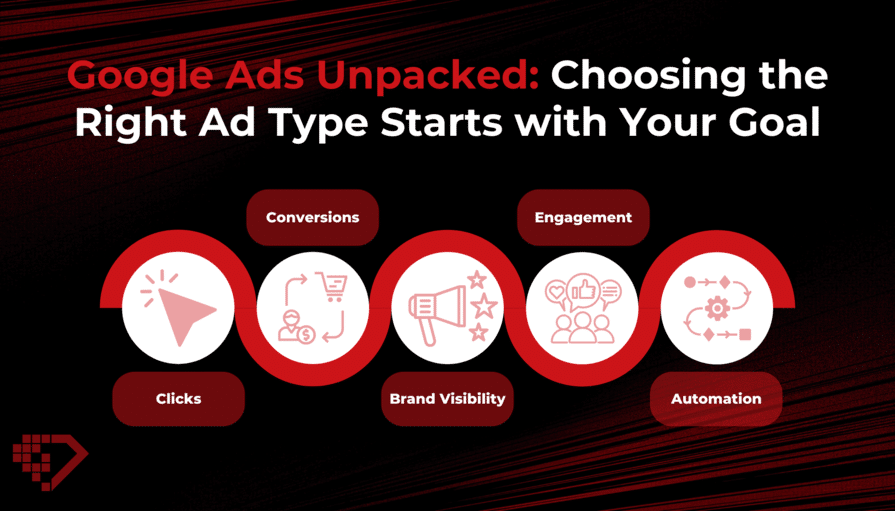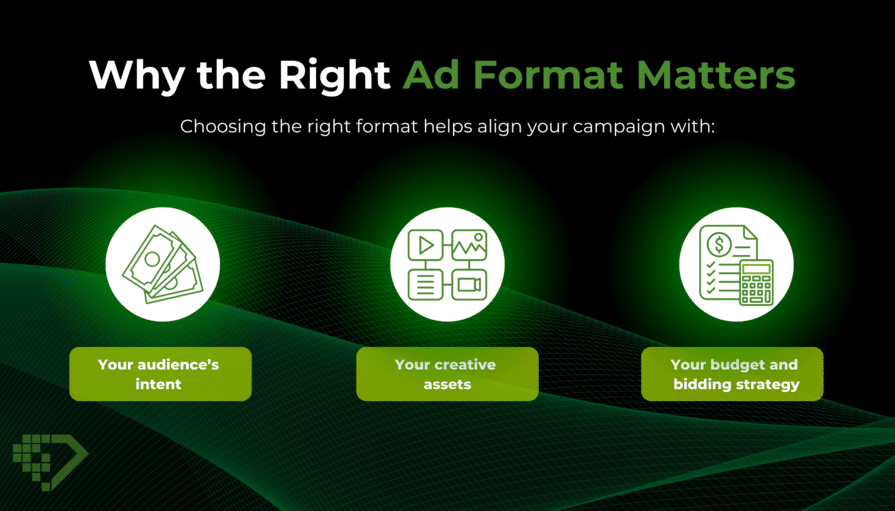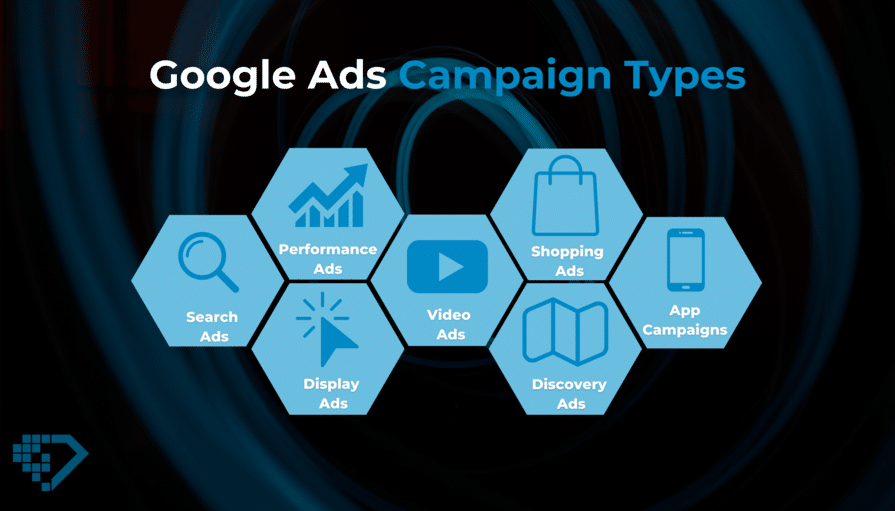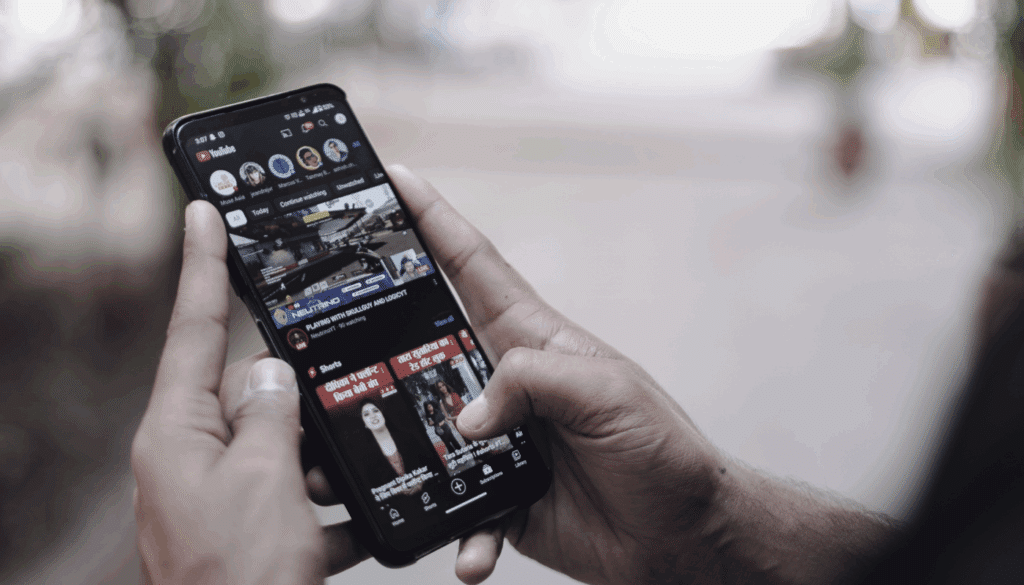Google Ads has long offered powerful ways to reach your audience – whether you’re aiming for clicks, conversions, or greater brand visibility. From text-based Search ads to dynamic Performance Max campaigns, different types of Google ads campaigns are designed for different goals.
That’s why choosing the right ad types is so important. The better the match between format and objective, the more efficiently your budget works – and the more likely you are to see results.
What are the different types of Google Ads? In this guide, we’ll walk you through the main formats available, explain when to use each one, and some insights to help you make the most of your Google Ads strategy.

Why the Right Ad Format Matters
Different types of Google Ads are built to support different outcomes. Some excel at capturing high-intent traffic right as someone is ready to buy. Others are better suited to building brand awareness or reconnecting with past visitors.
Using the wrong ad format for your objective can result in poor performance, wasted budget, and missed opportunities. On the flip side, when your ad format aligns with your customer’s intent, Google’s machine learning kicks in to optimise your results.
You get better placements, more relevant traffic, and higher ROI – all while the platform does more of the heavy lifting! Choosing the right format helps align your campaign with:
- Your audience’s intent (browsing, researching, or ready to buy)
- Your creative assets (text, image, or video)
- Your budget and bidding strategy
Here’s the golden rule: Let your business objective lead the way. Whether it’s leads, sales, awareness, or app installs, there’s a format designed to get you there.

Google Ads Campaign Types
- Search Ads
Text-based ads triggered by specific keyword searches on Google. Ideal for capturing high-intent traffic when users are actively looking for products or services. - Performance Max
A fully automated campaign type that uses AI and machine learning to serve ads across all of Google’s properties (Search, Display, YouTube, Gmail, and Discover) based on your goals and assets. - Display Ads
Visual banners that appear on websites, mobile apps, and Gmail. Useful for brand awareness, remarketing, and staying top of mind. - YouTube (Video) Ads
Video ads shown before or during YouTube content. Great for storytelling, education, or launching a product with impact. - Shopping Ads
Product listings featuring images, prices, and reviews that appear directly in Google Search and the Shopping tab. Highly effective for eCommerce businesses. - Discovery Ads
Visual, scrollable ads shown in the Google Discover feed, Gmail promotions, and YouTube Home. Designed for sparking interest during passive browsing. - App Campaigns
Ads specifically designed to drive mobile app installs or in-app actions, running automatically across all relevant Google surfaces.
Let’s break down the various types of Google Ads campaigns you can choose from, along with their strengths, use cases, and platform reach.
Search Ads: Capture Demand with High Intent
Appear on: Google Search, Maps, and Search partners
Best for: Local services, B2B, high-conversion keywords
Strengths: Intent-driven, measurable ROI
Weaknesses: Competitive and CPCs can be high
Search Ads are the original types of Google Ads campaigns. They appear when users actively search for specific keywords – think “emergency plumber Cape Town” or “digital marketing agency in South Africa.”
These text-based ads target people who are already in problem-solving or buying mode, which means you’re reaching them at exactly the right time. With strong copy, compelling offers, and optimised landing pages, Search Ads can deliver exceptional conversion rates.
Just be aware, high intent = high competition, especially in popular industries. Smart keyword targeting is key to keeping costs manageable.
Performance Max: Full Funnel with AI Power
Appear on: All Google properties (Search, Display, YouTube, Gmail, Maps, Discover)
Best for: eCommerce, service businesses, multi-goal campaigns
Strengths: Smart bidding, broad reach, automated targeting
Weaknesses: Limited manual control, less visibility into performance drivers
Performance Max (PMax) is Google’s AI-powered all-in-one campaign type. Rather than choosing where your ads appear, you provide creative assets and conversion goals. Google then does the rest, showing ads across all channels to the most likely converters.
It’s a powerful option for businesses looking to streamline their efforts, especially in ecommerce. PMax optimises across the entire funnel, from first impression to final sale.
However, it comes with a trade-off: less transparency. You won’t get granular data on which platforms or audiences perform best, which can make performance analysis tricky without the right tracking setup.
Display Ads: Ideal for Awareness & Retargeting
Appear on: Google Display Network (GDN), Gmail, apps, and partner websites
Best for: Top-of-funnel awareness, retargeting previous visitors
Strengths: Visual format, wide reach, cost-effective impressions
Weaknesses: Lower click-through rates if targeting isn’t refined
Display Ads are graphic-based ads that appear on millions of websites and apps in the Google Display Network. They’re great for brand awareness, visually introducing your product or service to a broader audience. They’re also highly effective for remarketing, helping you stay top of mind with users who’ve already interacted with your site or app.
While cost-per-click is generally lower than Search, Display campaigns require thoughtful targeting and engaging visuals to avoid “banner blindness.” Pairing them with retargeting audiences can dramatically improve ROI.
YouTube Ads: Visual Storytelling at Scale
Appear on: YouTube videos and video partner networks
Best for: Brand campaigns, explainers, product launches
Strengths: High engagement, large and growing audience
Weaknesses: Requires video content and production investment
With over 2 billion logged-in users monthly, YouTube offers unmatched reach for video-based ads. Whether it’s a skippable ad or a short bumper ad, YouTube lets brands connect emotionally with their audience through storytelling, tutorials, or testimonials.
Great for upper- and mid-funnel objectives, YouTube Ads help drive awareness and consideration, but performance relies heavily on your creative. You’ll need strong visuals and a message that lands within seconds.
The good news? Even small businesses can repurpose social video content into effective ads.
Shopping Ads: Product Visibility That Converts
Appear on: Google Search, Shopping tab, Images
Best for: eCommerce and online retailers
Strengths: High buyer intent, visual format with price and ratings
Weaknesses: Requires Merchant Centre setup and product feed maintenance
Shopping Ads are purpose-built for ecommerce. They showcase your products (complete with price, image, brand, and ratings) directly in search results, so customers see what they’re getting before they even click.
Because these ads appear in response to high-intent queries (like “buy hiking boots online”), they often deliver better conversion rates than standard Search Ads.
To get started, you’ll need a Google Merchant Centre account, an up-to-date product feed, and a well-organised inventory. The upfront setup can be worth it, especially if you sell a range of physical products.
Discovery Ads: Visually Engaging Across the Google Ecosystem
Appear on: YouTube Home, Gmail Promotions, Discover feed
Best for: Brand discovery, product exploration, remarketing
Strengths: Large reach, native-style format
Weaknesses: Less intent-driven than Search or Shopping
Discovery Ads are designed to catch users while they’re scrolling and exploring, not necessarily searching. These ads appear seamlessly in content feeds, blending in with what users are already browsing.
That makes them ideal for brand discovery or re-engaging previous site visitors with personalised offers. They rely on striking visuals, short headlines, and smart targeting to drive curiosity.
Discovery Ads sit somewhere between Display and Social – less interruptive than traditional ads, but more passive than Search.
App Campaigns: Promote Mobile Apps Across Google
Appear on: Search, Google Play, YouTube, Display
Best for: Driving app installs, in-app conversions, and engagement
Strengths: Fully automated campaign delivery
Weaknesses: Limited to businesses with a mobile app
If your business offers a mobile app, Google’s App Campaigns make it easy to get it in front of the right users. By pulling creative assets from your app store listing, these campaigns promote your app across multiple Google surfaces.
You choose your objective (installs, in-app actions, or re-engagement) and Google optimises your campaign accordingly.
App Campaigns are especially helpful for SaaS (Software as a Service) platforms, mobile games, or businesses wanting to build a loyal mobile user base. Just be ready to monitor app metrics like cost-per-install and user retention for true success.

Google Ads Campaign Types Comparison Table
| Ad Type | Best For | Funnel Stage | Creative Required | Automation Level | Key Channel |
| Search Ads | Lead generation, high intent | Bottom (Conversion) | Text | Manual to Semi-Auto | Google Search |
| Performance Max | Full-funnel automation | All stages | Text, image, video | High | All Google channels |
| Display Ads | Awareness, retargeting | Top/Mid | Banner images | Medium | GDN, Gmail, Apps |
| YouTube Ads | Storytelling, product explainers | Top/Mid | Video | Medium to High | YouTube |
| Shopping Ads | eCommerce and product sales | Bottom (Purchase) | Product feed + images | Medium | Search, Shopping tab, Images |
| Discovery Ads | Passive browsing, remarketing | Mid | Visual + headline | Medium | Discover, Gmail, YouTube Home |
| App Campaigns | Mobile app installs and engagement | All stages (App-only) | App store listing assets | High | Search, YouTube, Display, Play |
Key Takeaways
What are the different types of Google Ads, and which one should you choose? The truth is, there’s no single “best” Google Ads format – only the best fit for your goals. Start with your objectives, and then choose the ad type (or mix) that aligns with your audience and your team’s capacity.
Not sure where to start? We can help! Explore our Google Ads services or learn how we drive growth with Pay-Per-Click campaigns.



